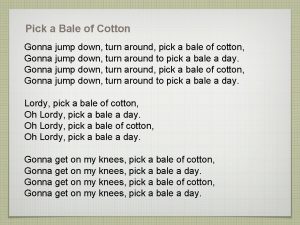and you are gonna like it Introduction to

































- Slides: 33

. . . and you are gonna like it! Introduction to Beef Quality Grading By James Berry

Grading vs. Tasting Why? • Of all BBQs you have, you could not possibly taste every animal! • What if the product is not consumable? • Tasting is too time consuming and subjective

What is the purpose beef carcass grading? • To allow beef producers, packers, and retailers to be paid for the level of quality product they distribute. • The USDA implemented meat grading to ensure that the product is of the right quality that consumers want. • To create a basis for comparison and data in the beef industry. • It is NOT mandatory for beef producers to use – But many markets such as Safeway and Kroger require it.

How do beef grades affect me? • They guarantee a grade of meat that we can trust at the quality level of the product you are buying. • They increase the chance that we will be satisfied with our product.

What are the two types of grades? • Quality Grade – Qualitative • Yield Grade - Quantitative


What are the 8 types of quality grades? • Three for purchase at the store: Prime (very rare) Choice – Starting to be the standard at stores Select – used to be the standard • Others consumed by people in different ways Standard, Commercial, Utility, Cutter, and Canner

What is the purpose of Quality Grades? • Reflects the differences in the eating quality of meat based on: Marbling scores - the amount of fat interspersed in the muscle. Maturity scores - reflects the age of the animal at slaughter.

Factors influencing Quality Grade 1. Direct • Marbling • Maturity 2. Indirect • Texture • Firmness • Color



No fat is good right? . . . Not always. Quality Grade Prime Upper 2/3 of Choice Lower 1/3 of Choice Select Standard Odds of poor steak 1 in 26 1 in 19 1 in 7 1 in 5 1 in 2

Prime • This carcass has superior marbling, proper carcass conformation, and adequate maturity. – Found in fine restaurants and gourmet stores. • Not economical for meat packers – The cattle are required to get very fat to obtain enough marbling – A small percentage of cattle meet the conformation standards.

Choice • This is the most economical and most desirable carcass grade. – Adequate marbling and carcass conformation are required.

Select • (Used to be called "Good") This beef may be referred to as "no-roll" since it isn't stamped with the USDA grade. – Must have slight marbling. – This meat is inspected but not marked with a stamp as Prime and Choice.

Standard • Usually older animals and thin animals. – Minimum marbling or below average carcass conformation fits into this category.

Commercial • Includes the designations of: Cutter Canner Utility. – This meat is usually processed into lunch meats, soup, and canned meat products.

Cull • Not acceptable for human consumption. – Often times put into animal consumption or used to make other products. – No longer used as animal consumption products • BSE

Tenderness

Quality of Taste

Notice the visual difference in marbling (intramuscular fat) at each quality Grade

Moderately Abundant Primeo Modest Choiceo

Slightly Abundant Prime- Modest Choiceo

Moderate Choice+ Modest Choiceo

Small Choice- Modest Choiceo

Slight Select Modest Choiceo



Based on marbling, what would you grade the cut on the left?

Based on marbling, what would you grade the cut on the left? Prime

So what do we take from this? • Why do we need to know this information? • Do we go and buy the highest quality? • How does beef grading affect how we eat?

Let’s get Grilling!

Sources • Most information, slides and pictures provided by Dr. Jon Beckett, Cal Poly, SLO • USDA • National Cattlemen’s Beef Association • Slides 25 & 26 - www. ag. auburn. edu/ ~sschmidt/meats/sld 011. htm
 Insidan region jh
Insidan region jh Personification in the song roar
Personification in the song roar You lead me follow
You lead me follow Palomar eservices
Palomar eservices Jesus king of my heart
Jesus king of my heart Remo ualberta
Remo ualberta Is lion king hamlet
Is lion king hamlet Gonna buy me a knife with a blade ten inches long
Gonna buy me a knife with a blade ten inches long Jump up turn around pick a bale of cotton
Jump up turn around pick a bale of cotton Dr jean cool bear hunt
Dr jean cool bear hunt Ain't no rock gonna cry in my place
Ain't no rock gonna cry in my place The deacon went down in the cellar to pray
The deacon went down in the cellar to pray Slimy yet satisfying gif
Slimy yet satisfying gif Dance dance dance in the freedom we know
Dance dance dance in the freedom we know I am going to verb tense
I am going to verb tense Freedom we know
Freedom we know We're gonna jump jump jump in the river
We're gonna jump jump jump in the river You thought i was altogether like you
You thought i was altogether like you Whats a clause
Whats a clause You sound like you re from london
You sound like you re from london Tell me what you eat and i shall tell you what you are
Tell me what you eat and i shall tell you what you are I would prefer grammar
I would prefer grammar Which features of the sun look like huge cloudlike arches?
Which features of the sun look like huge cloudlike arches? Why does ethanol look like water but behave more like wood?
Why does ethanol look like water but behave more like wood? Like minds like mine
Like minds like mine What does he look like?
What does he look like? What does he look like
What does he look like I like the flowers
I like the flowers Language
Language Lawrence kohlberg
Lawrence kohlberg Like father like son in italian
Like father like son in italian Do you love the rain
Do you love the rain You are what you eat do you agree or disagree
You are what you eat do you agree or disagree If you think you can you can poem
If you think you can you can poem
























































